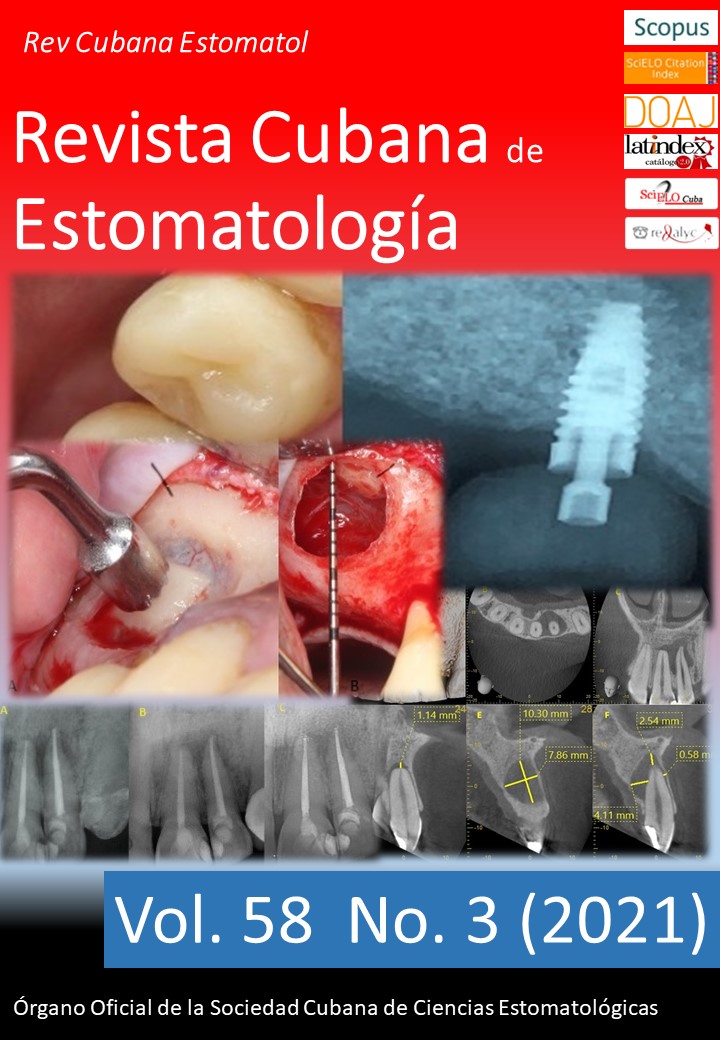Peri-implant mucositis associated to corrective orthodontics
Keywords:
mucositis, orthodontic anchorage methods, corrective orthodontics.Abstract
Introduction: Orthodontic miniscrews are temporary anchorage devices widely used in corrective orthodontics. However, it has been reported in the literature that their clinical success rate is not high, due to failures related to the loss of stability. Anchorage may be affected by factors associated to the type of implant, its surgical management and the host. Host-related factors include peri-implant tissue inflammation or mucositis, which though reversible, its early treatment is necessary to prevent expansion into and damage to the hard tissue (peri-implantitis).
Objective: Describe a clinical case of peri-implant mucositis associated to a temporary orthodontic anchorage device.
Case presentation: A female patient attends clinical consultation with pain in the anterior zone of her upper maxilla. Intraoral examination revealed the presence of orthodontic appliances with an anchorage mechanism: two orthodontic miniscrews located at the level of the upper canines. Surgical removal was performed of the orthodontic miniscrews, antibiotics were indicated and histopathological testing was conducted to rule out malignancy. The patient was diagnosed with peri-implant mucositis.
Conclusions: Surgical removal of orthodontic miniscrews is an excellent alternative to prevent the progress of the lesion into hard tissues. Pain signs, reddening and bleeding were all eliminated with the technique applied.
Downloads
References
Andrucioli MCD, Matsumoto MAN, Saraiva MCP, Feres M, Figueiredo LC de, Sorgi CA, et al. Successful and failed mini-implants: microbiological evaluation and quantification of bacterial endotoxin. J Appl Oral Sci. 2018;26: e20170631. DOI: 10.1590/1678-7757-2017-063
Yanaguizawa MS, Suzuki SS, Martinez EF, Suzuki H, Pelegrin MCJ, Garcez AS. Effects of Low-Level Laser Therapy in Orthodontic Patients on Immediate Inflammatory Response After Mini-Implants Insertion: A Preliminary Report. Surg de láser fotomed. 2017;35(1):57-63. PMID: 27813716
Alharbi F, Almuzian M, Bearn D. Miniscrews failure rate in orthodontics: systematic review and meta-analysis. Eur. J. Orthod. 2018;40(5):519-30. PMID: 29315365
Uesugi S, Kokai S, Kanno Z, Ono T. Prognosis of primary and secondary insertions of orthodontic miniscrews: What we have learned from 500 implants. Am J Orthod Dentofac. 2017;152(2):224-31. PMID: 28760284
Uesugi S, Kokai S, Kanno Z, Ono T. Stability of secondarily inserted orthodontic miniscrews after failure of the primary insertion for maxillary anchorage: Maxillary buccal area vs midpalatal suture area. Am J Orthod Dentofac. 2018;153(1):54-60. PMID: 29287652
Salvi GE, Cosgarea R, Sculean A. Prevalence and Mechanisms of Peri-implant Diseases. J Dent Res. 2017;96(1):31-7. PMID: 27680028
Garg K, Gupta M. Assessment of stability of orthodontic mini-implants under orthodontic loading: A computed tomography study. Indian J Dent Res. 2015;26(3):237. PMID: 26275187
Azeem M, Haq AU, Awaisi ZH, Saleem MM, Tahir MW, Liaquat A. Failure rates of miniscrews inserted in the maxillary tuberosity. Dental Press J Orthod. 2019;24(5):46-51. PMID: 31721946
Aly SA, Alyan D, Fayed MS, Alhammadi MS, Mostafa YA. Success rates and factors associated with failure of temporary anchorage devices: A prospective clinical trial. J Invest Clin Dent. 2018;9(3):e12331. PMID: 29512336
Cheng SJ, Tseng IY, Lee JJ, Kok SH. A Prospective Study of the Risk Factors Associated with Failure of Mini-implants Used for Orthodontic Anchorage. Int J Oral Max Impl. 2004;19(1):100-6. PMID: 14982362
Chaddad K, Ferreira AndréFH, Geurs N, Reddy MS. Influence of Surface Characteristics on Survival Rates of Mini-Implants. Angle Orthod. 2008 [acceso: 02/04/2020]; 78(1):107-13. Disponible en: https://meridian.allenpress.com/angle-orthodontist/article/78/1/107/58672/Influence-of-Surface-Characteristics-on-Survival
Lai T-T, Chen M-H. Factors affecting the clinical success of orthodontic anchorage: Experience with 266 temporary anchorage devices. J. Dent Sci. 2014 [acceso: 02/04/2020]; 9(1):49-55. Disponible en: https://www.sciencedirect.com/science/article/pii/S1991790213000317
Jing Z, Wu Y, Jiang W, Zhao L, Jing D, Zhang N, et al. Factors Affecting the Clinical Success Rate of Miniscrew Implants for Orthodontic Treatment. Int J Oral Maxillofac Implants. 2016;31(4):835-41. PMID: 27447150
Tortamano A, Dominguez GC, Haddad ACSS, Nunes FD, Nacao M, Morea C. Periodontopathogens around the surface of mini-implants removed from orthodontic patients. Angle Orthod. 2012;82(4):591-5. PMID: 22839769
Apel S, Apel C, Morea C, Tortamano A, Dominguez GC, Conrads G. Microflora associated with successful and failed orthodontic mini-implants. Clin. Oral Implants Res. 2009;20(11):1186-90. PMID: 19719743
Published
How to Cite
Issue
Section
License
Authors retain all rights to their works, which they can reproduce and distribute as long as they cite the primary source of publication.
The Rev Cubana Estomatol is subject to the Creative Commons Attribution-Non-Commercial 4.0 International License (CC BY-NC 4.0) and follows the publication model of SciELO Publishing Schema (SciELO PS) for publication in XML format.
You are free to:
- Share — copy and redistribute the material in any medium or format.
- Adapt — remix, transform, and build upon the material.
The licensor cannot revoke these freedoms as long as you follow the license terms.
Under the following terms:
Attribution — You must give appropriate credit, provide a link to the license, and indicate if changes were made. You may do so in any reasonable manner, but not in any way that suggests the licensor endorses you or your use.
- NonCommercial — You may not use the material for commercial purposes.
No additional restrictions — You may not apply legal terms or technological measures that legally restrict others from doing anything the license permits.
Notices:
- You do not have to comply with the license for elements of the material in the public domain or where your use is permitted by an applicable exception or limitation.
- No warranties are given. The license may not give you all of the permissions necessary for your intended use. For example, other rights such as publicity, privacy, or moral rights may limit how you use the material.


